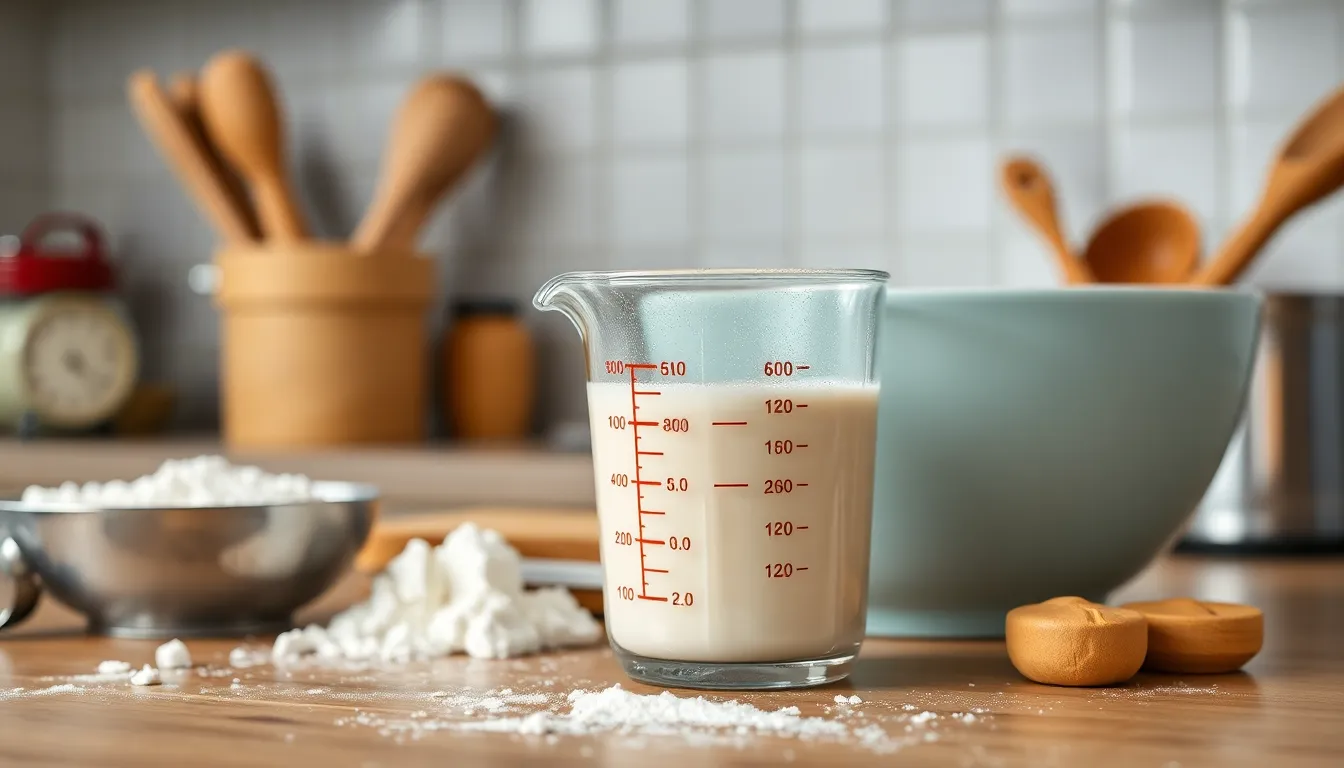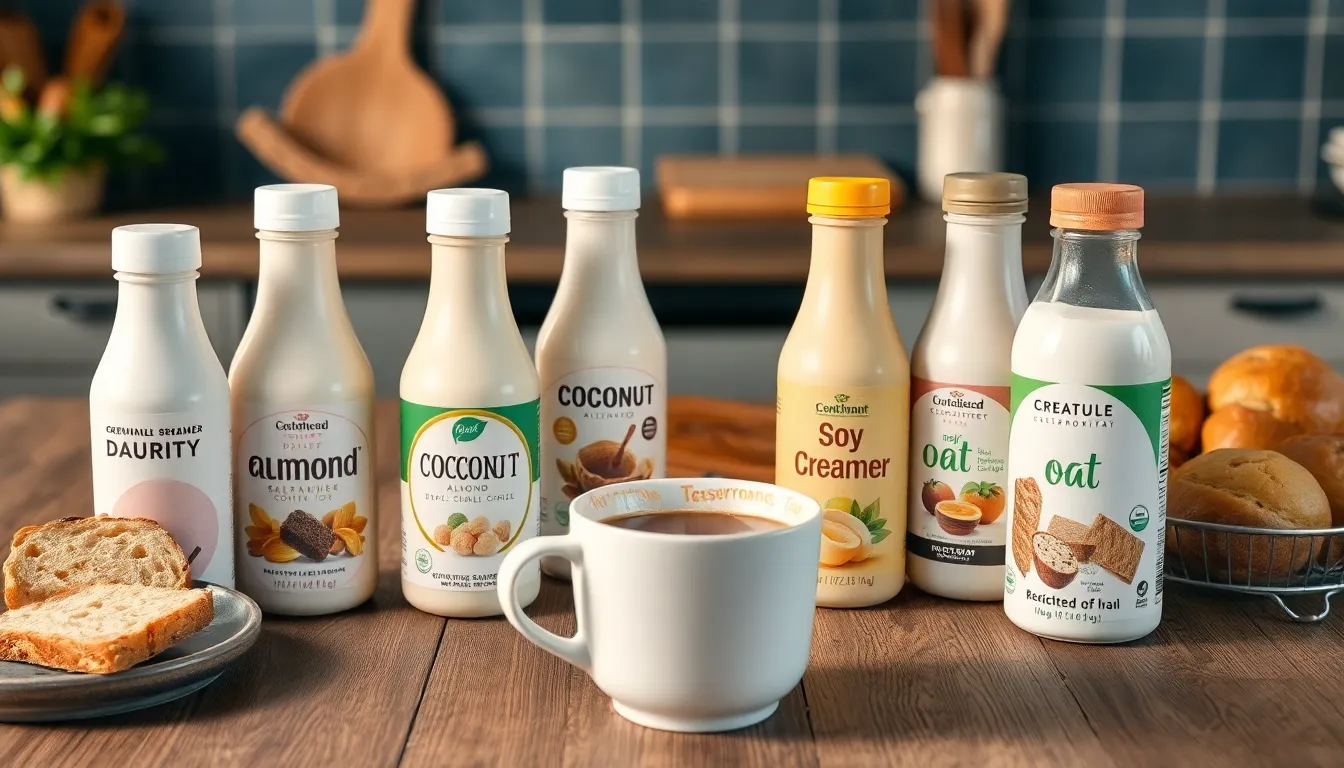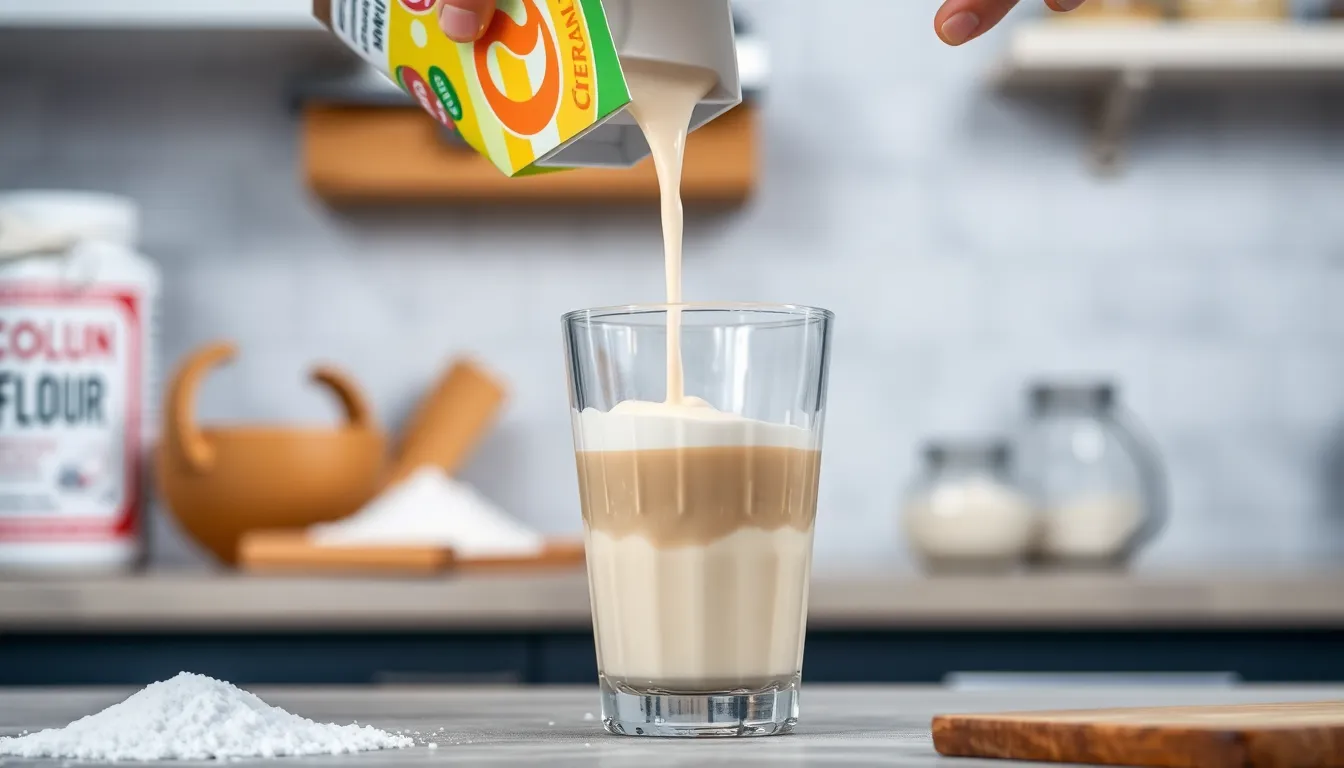Can you use creamer instead of milk? If you’ve ever found yourself with an empty milk carton but a full container of coffee creamer, you might be wondering if creamer can pinch-hit for milk in your recipes.
Whether you’re baking cookies, making mashed potatoes, or just wanting something for your cereal, the question of substituting creamer for milk is common. Coffee creamer—both liquid and powdered—is designed primarily for coffee, but it’s versatility might surprise you. While creamers can work as substitutes in some situations, there are important differences in composition, flavor profiles, and nutritional content you’ll want to consider before making the swap.
What Is Coffee Creamer and How Does It Differ from Milk
Coffee creamer is a dairy or non-dairy product specifically designed to lighten and flavor coffee. It’s available in liquid form in refrigerated cartons or shelf-stable containers, and as a powdered product in jars or individual packets. Common ingredients in creamers include water, sugar, vegetable oil, and various additives for texture, flavor, and shelf stability.
Milk and creamer differ significantly in composition. Milk is a natural dairy product containing protein, calcium, vitamins, and lactose. Creamer, particularly non-dairy varieties, contains vegetable oils (often hydrogenated), corn syrup solids, and various emulsifiers. The fat content in creamer tends to be higher than in milk, with less protein and calcium.
Flavor profiles separate these two products distinctly. Milk has a subtle, natural dairy taste that complements coffee without overwhelming it. Creamers come in many flavors like vanilla, hazelnut, or caramel, designed to add sweetness and flavor complexity to beverages. Many customers at my local coffee shop prefer flavored creamers for their morning brew, citing the extra flavor dimension they provide.
Nutritionally, milk offers more benefits than most commercial creamers. One cup of whole milk contains approximately 8g of protein and 300mg of calcium. Creamer typically provides minimal protein and calcium but delivers more calories from fat and sugar. During a recent recipe testing session, I noticed how differently these ingredients behaved when heated – milk developed a natural richness, while creamer created a distinctly sweeter profile.
When considering substitutions, texture differences become important. Milk has a thinner consistency compared to many liquid creamers, which are formulated to be thicker and creamier. This texture variance affects how each performs in recipes requiring exact viscosity. The powdered version of creamer dissolves differently than milk powder, creating unique mouthfeel characteristics in finished dishes.
Cooking and Baking with Coffee Creamer

Coffee creamer serves as a practical alternative to milk in many cooking and baking applications. When using creamer instead of milk, you’ll need to account for differences in sweetness, fat content, and potential heat sensitivity that might affect your final dish.
Substitution Ratios for Different Recipes
Converting milk measurements to coffee creamer requires exact ratios for optimal results. For whole milk replacement, use approximately 3 tablespoons of powdered creamer or 8 tablespoons of liquid creamer to substitute for ¼ cup of milk. These proportions may need adjustment depending on the recipe type and desired outcome. Creamer’s concentrated nature means you’ll typically use less than the called-for milk quantity, especially with powdered varieties. Baked goods like cakes and cookies often respond well to a 3:4 ratio of creamer to milk, creating rich, moist textures. Savory dishes such as mashed potatoes or cream-based soups benefit from a 1:2 ratio to avoid overwhelming sweetness while maintaining creaminess.
How Creamer Affects Taste and Texture
Coffee creamer introduces distinct flavor elements that transform your culinary creations. The added sugars and flavorings in most creamers contribute sweetness and complexity absent in plain milk, improving desserts but potentially clashing with savory recipes. Vanilla or hazelnut creamers pair exceptionally well with baked goods, imparting subtle aromatic notes. Texture changes are equally important when substituting creamer for milk. Creamers typically create richer, thicker consistencies in foods compared to milk’s lighter profile. This thickness can produce more decadent desserts and creamier sauces but might also alter the expected outcome in recipes requiring precise liquid ratios. Coffee creamer’s different cooking behavior includes a tendency to curdle at high temperatures more readily than milk, making it less stable for certain cooking methods like prolonged simmering or boiling.
Types of Creamers That Work Best as Milk Substitutes

Not all creamers perform equally when substituting for milk in recipes or beverages. The effectiveness depends largely on the type of creamer you’re using and its composition relative to your intended application.
Dairy-Based Creamers
Dairy-based creamers provide the closest approximation to milk’s natural properties. These products contain actual milk derivatives such as cream and additional milk solids, delivering a rich texture similar to what you’d expect from whole milk. Their higher fat content creates a velvety mouthfeel that enhances coffee drinks and adds richness to baked goods. The familiar dairy flavor profile makes these creamers particularly suitable for recipes where milk’s natural taste is important. When cooking savory dishes like mashed potatoes or cream-based soups, dairy creamers blend seamlessly without introducing competing flavors. For baking applications requiring the protein structure that milk provides, dairy creamers offer more comparable results than their non-dairy counterparts.
Non-Dairy and Plant-Based Options
Non-dairy creamers offer versatile alternatives for those with lactose intolerance or following plant-based diets. Coconut-based creamers provide excellent creaminess with a subtle tropical note that pairs beautifully with baked goods and desserts. Almond creamers contribute a lighter texture and nutty undertone, working particularly well in coffee drinks and breakfast recipes. Soy creamers contain more protein than other plant-based options, making them better substitutes for milk in recipes requiring structure. Oat creamers offer a neutral, creamy taste profile closest to milk, with natural sweetness that complements both sweet and savory applications. Rice creamers provide the mildest flavor impact, allowing other ingredients to shine while still adding the necessary moisture and texture. These plant-based options typically contain fewer nutrients than milk but often compensate with fortification, though they may include additional sugars and stabilizers that can affect recipe outcomes.
Health Considerations When Using Creamer Instead of Milk

Substituting creamer for milk involves several important health factors to consider. These considerations span from nutritional composition to dietary needs, which can significantly impact your overall health when making this switch.
Nutritional Differences
Milk provides substantially more nutritional benefits than most creamers on the market. One cup of whole milk contains approximately 300 mg of calcium and 8 grams of protein, supporting bone health, muscle repair, and overall development. Milk’s naturally occurring lactose helps maintain stable blood sugar levels throughout the day.
Commercial creamers often lack these essential nutrients unless they’re specifically fortified. Most non-dairy creamers contain minimal calcium or vitamin D compared to milk, making them less beneficial for bone health, especially for children and older adults. They typically include added sugars, artificial flavors, and emulsifiers instead of natural nutrients.
The sugar content in creamers presents another nutritional concern. While milk contains natural sugars, creamers often have additional sweeteners that can increase your overall sugar consumption. This higher sugar intake potentially raises risks for obesity and type 2 diabetes over time.
Dietary Restrictions and Allergies
Non-dairy creamers offer valuable alternatives for people with lactose intolerance or milk allergies. These products are typically lactose-free and don’t contain milk proteins that cause digestive discomfort or allergic reactions in sensitive individuals.
Calorie content varies significantly between different creamer products. Some non-dairy options contain fewer calories than whole milk, making them suitable for calorie-conscious consumers. Others pack additional fats and sugars that actually increase caloric intake beyond what’s found in milk.
Reading product labels becomes essential when choosing creamers for dietary purposes. The nutritional composition differs dramatically between brands and varieties, with some providing better nutritional profiles than others. For instance, plant-based creamers may offer different nutritional benefits depending on their base ingredient (coconut, almond, soy, etc.).
Fortified creamers attempt to address nutritional gaps by adding calcium, vitamins, or proteins, though these added nutrients may not be absorbed as efficiently as those naturally occurring in milk. Your exact health needs and restrictions eventually determine whether the trade-offs of using creamer instead of milk align with your personal health goals.
Best Uses for Creamer as a Milk Alternative

Creamer serves as an effective milk substitute in exact culinary applications, offering unique flavor profiles and textural qualities that differ significantly from traditional milk. Understanding where creamer excels helps you make the most of this alternative.
In Coffee and Tea
Coffee creamer enhances hot beverages with a richer, creamier consistency compared to regular milk. Its composition of vegetable oils, sweeteners, and flavorings creates a more indulgent experience in your morning cup. While milk dilutes coffee due to its higher water content, creamer concentrates flavor and adds silky smoothness.
Quantity adjustments are essential when making the switch from milk to creamer. For replacing 1/4 cup of whole milk, use approximately 3 tablespoons of powdered creamer or 8 tablespoons of liquid creamer. Start with less and adjust according to your taste preferences since creamer delivers more sweetness and richness per spoonful.
Temperature control matters significantly when using creamer in hot beverages. Creamers can curdle or develop bitter notes if exposed to excessive heat, so add them to slightly cooled beverages for optimal results and flavor preservation.
In Sweet and Savory Recipes
Creamer works exceptionally well in desserts and sweet applications where its added sweetness and flavor compounds complement the dish. Custards, puddings, and cream-based sauces benefit from the velvety texture and enhanced richness that creamer provides.
Savory cooking presents more challenges when substituting creamer for milk. The added sugars and flavor components in most creamers can clash with savory flavor profiles, potentially disrupting the balance of your dish. Neutral-flavored creamers offer better results in savory applications like mashed potatoes or cream-based soups.
Milk maintains superior versatility across all cooking applications due to its natural composition of water, proteins, fats, and lactose without artificial additives. Its neutral profile makes it the preferred choice for recipes requiring pure dairy flavor and balanced moisture content.
Cooking techniques require adaptation when using creamer instead of milk. Lower heat settings and gentle incorporation methods prevent separation and preserve the creamer’s texture contribution to your final dish.
When Not to Use Creamer as a Milk Substitute

Coffee creamer falls short as a milk replacement in several key situations where nutritional content and cooking properties matter significantly. Recipes requiring milk’s exact properties depend on its protein content and natural enzymes to achieve the desired texture and structure.
Avoid using creamer instead of milk in these scenarios:
- Cooking or baking recipes that rely on milk’s exact chemical properties, as creamer lacks the proteins and enzymes needed for proper structure development
- Infant and children’s diets where calcium and protein intake is critical for bone and muscle development (one cup of whole milk provides about 300mg of calcium and 8g of protein)
- Nutritionally focused meals for individuals with exact dietary needs requiring high-quality protein and essential nutrients
- Blood sugar management plans since many creamers contain added sugars that can cause blood glucose spikes unlike milk’s natural lactose
- Low-calorie diets as creamers often contribute excess calories from added fats and sweeteners
Savory dishes particularly suffer when creamer replaces milk, as the added sweeteners and artificial flavors clash with herbs and spices. Soups, sauces, and casseroles develop odd flavor profiles and potentially separate during cooking due to creamer’s different fat composition and heat stability.
For individuals focused on bone health or muscle maintenance, creamer provides almost none of milk’s calcium, vitamin D, or protein benefits. This nutritional gap becomes especially problematic for growing children, older adults concerned with bone density, or athletes recovering from physical activity.
High-heat cooking techniques also present challenges when using creamer, as the emulsifiers and stabilizers in many commercial creamers break down at elevated temperatures, causing curdling or separation in the final dish.
Conclusion
Coffee creamer can indeed stand in for milk when you’re in a pinch but requires thoughtful adjustments to achieve optimal results. Your choice of creamer type matters significantly—dairy-based options work better in savory dishes while flavored varieties shine in desserts.
Remember that nutritional profiles differ dramatically between milk and creamer. If nutrition is your priority stick with milk for its protein and calcium benefits.
The substitution works best in recipes where flavor enhancement is welcome like coffee drinks and sweet treats. For high-heat cooking techniques or dishes requiring precise chemical reactions proceed with caution.
By understanding these differences you’ll be equipped to make smart substitutions that don’t compromise your culinary creations—whether you’re baking cookies or preparing your morning coffee.
Frequently Asked Questions
Can coffee creamer replace milk in recipes?
Yes, coffee creamer can substitute for milk in many recipes, but with adjustments. Both liquid and powdered creamers work, though the results will differ from using milk. Creamer typically contains more fat and sugar while offering less protein and calcium than milk. For best results, use approximately 3 tablespoons of powdered creamer or 8 tablespoons of liquid creamer for every ¼ cup of milk, adjusting based on the recipe type.
How do milk and coffee creamer differ nutritionally?
Milk is a natural source of protein, calcium, and essential nutrients that support bone and muscle health. Coffee creamer generally contains higher fat content, more calories from sugar, and minimal protein or calcium unless fortified. Most commercial creamers include water, sugar, and vegetable oils, along with additives and flavorings. These nutritional differences make milk a healthier option for regular consumption, while creamer serves as an occasional substitute.
Do dairy-free creamers work as milk substitutes?
Yes, plant-based creamers (coconut, almond, soy, oat, rice) work as milk substitutes, especially for those with dietary restrictions. Each type offers unique flavor and texture characteristics. Soy creamers provide more protein, while oat creamers offer a neutral taste. However, most plant-based options contain fewer nutrients than milk, though some are fortified. Choose based on your recipe needs and dietary preferences.
Will coffee creamer change the taste of my recipe?
Coffee creamer will definitely alter your recipe’s flavor profile. Unlike milk’s subtle taste, creamers contain added sugars and flavorings that contribute sweetness and complexity. This can enhance desserts but may clash with savory dishes. For sweet recipes, flavored creamers can add interesting dimensions, while neutral-flavored options work better for savory applications. Always consider the creamer’s flavor when deciding on substitution quantities.
What’s the best creamer-to-milk ratio for baking?
For baked goods, use a 3:4 ratio of creamer to milk (¾ cup creamer for every 1 cup of milk called for). Sweet recipes like cakes and cookies often benefit from creamer’s added richness and sweetness. For savory dishes, reduce to a 1:2 ratio (½ cup creamer for every 1 cup milk) to avoid excessive sweetness. Adjust these ratios based on your recipe’s specific needs and the creamer’s consistency.
Does creamer affect the texture of recipes?
Yes, creamer typically has a thicker consistency than milk, which creates richer textures in recipes. This can be beneficial for creamy desserts like puddings and custards but may alter outcomes in recipes requiring precise liquid ratios. Additionally, creamer is more prone to curdling at high temperatures, making it less stable for certain cooking methods. Consider reducing other liquids slightly when using creamer as a substitute.
When should I avoid using creamer instead of milk?
Avoid using creamer as a milk substitute in infant and children’s diets, nutritionally focused meals, and low-calorie or blood sugar management plans. It’s also unsuitable for recipes that rely on milk’s protein and enzymes for proper structure. Savory dishes may develop odd flavor profiles with creamer, and high-heat applications may cause separation or curdling. When nutritional content is critical, stick with milk or a more nutritionally equivalent alternative.
Can I use flavored creamers in cooking?
Flavored creamers work well in complementary sweet recipes where their taste enhances the dish—like vanilla creamer in custards or hazelnut creamer in coffee cakes. However, they’re generally unsuitable for savory cooking unless the flavor specifically complements the dish. For versatility, keep unflavored or “original” creamer on hand for cooking purposes, saving flavored varieties for specific recipes where their taste profile adds value.

